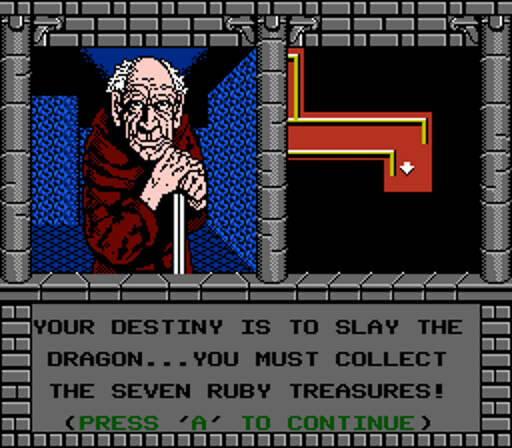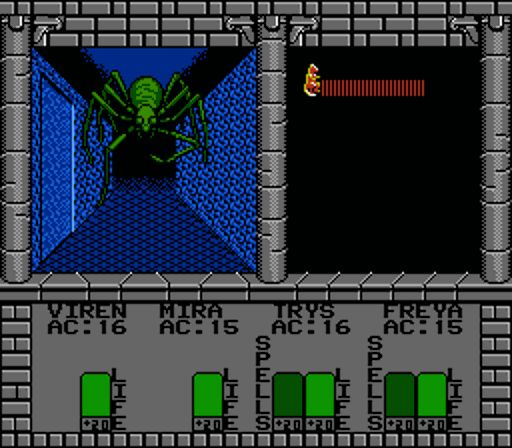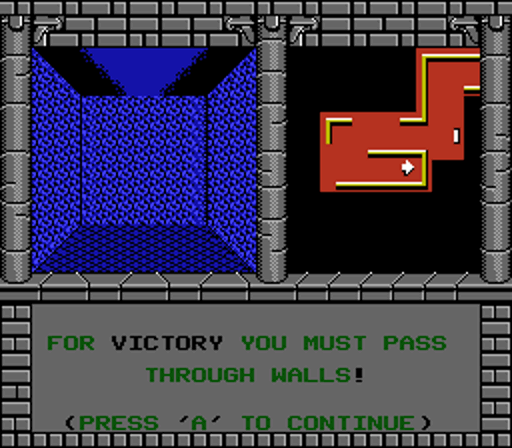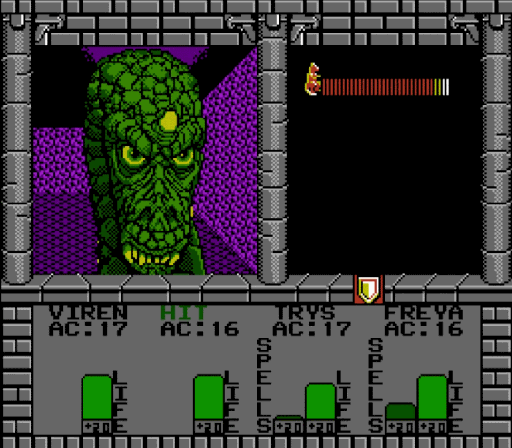2018-09-20: Swords and Serpents (NES)
Swords and Serpents is a game from my young childhood that always fascinated me. It was one of those games I rented multiple times as a kid and never really got far in. At the time I didn't have the patience to map dungeons and grind my party up, so I always hit a brick wall around floor 3 when my capacity to memorize the floors gave out. As an adult with several games like this under my belt, I saw this in Big Bad Game-a-thon and decided it was time to finally finish it.
I rolled a pretty balanced party of a Warrior, Thief, and two Mages and dropped in. The game is light on plot, giving you the first, last, and only real plot point of the game just five steps into the dungeon:
And just around the corner from that guy is a rather strangely colored NPC providing you with a secondary major goal:
So seven ruby treasures, a black crystal, and a dragon to slay. Got it. A short ways across floor 1 you find a Temple, which provides healing and resurrection, and an Armory to buy gear. Combat can occur randomly as you move about the dungeon, and also when you step on certain tiles with forced encounters. Combat itself is super basic. There are no menus, you simply press A to attack when a character's turn is up (during which their name is highlighted in green). You can hold up to target the enemy's head and down to target their legs, but this seems to do absolutely nothing to damage while making the attack less accurate.
During combat, as well as out of combat, you can press B to open the magic menu, to allow your mages to cast healing, offensive, and utility spells. Combat magic is practically useless as it's far more economical to just heal the damage you take at the cost of 1-2MP than it is to use a 4MP nuke to end the battle faster. So battle comes down to mashing A (or, if you're a brat like me, holding turbo-A), sometimes tapping B to heal, and choosing whether or not to flee. The lacking simplicity is offset by the fact that for 75% of the game, battles take about 10 seconds.
As you traverse the dungeon, you come across hints in green text referring to "Victory". These imply pretty heavily that they're clues for the end of the game, but their exact use is left unclear as you gather them. With few exceptions there's one clue on each level, typically in some out of the way location. They're all necessary to piece together the final puzzle-- with the exception of floor 14's; it's a repeat for some reason.
The dungeon is a 16x16x16 cube and the early floors are pretty basic. Later on, floors start coming with gimmicks: floor 5 introduces you to wrap-around floors (as well as the second temple and armory), floor 6 introduces floor traps and has them in spades, floor 8 consists almost entirely of invisible walls, floor 9 is a nexus of zoom tubes shooting you all over the dungeon. These floors are super creative and engaging and presented unique fun challenges for exploration, even if the combat was bland. I left this block of floors feeling like the challenging dungeon layouts had pretty thoroughly kicked my butt, and I felt satisfied for making it to floor 10 without any spoilers or guidance.
Floor 10 hosts the third and final temple and armory, as well as the NPC seeking the ruby treasures. Up until now if you'd been meticulous in exploring the dungeons, you'd found five. The NPC of course wants all seven, and the final two are in the next floors below.
Floor 11 is called "Sword", is shaped like a sword, and hides the ruby sword behind a puzzle that requires moving to a specific location along the sword-shaped map and doing a specific series of movements to make the actual sword appear. It was cute but not very difficult or engaging; a hint a few floors up tells you exactly what to do with no ambiguity.
That's pretty much where the unique gimmicks end. Floor 12 has the black crystal the NPC way up on floor 1 wanted, but otherwise is just a grid of slaloming hallways designed to maximize how long it takes to walk through them. Once you grab the crystal and return to the very top of the dungeon via walking or zoom tubes, the NPC rewards you with a one-way trip to floor 13. It's here that you find the final ruby treasure, presuming you've been finding the others anyway.
The floor 10 NPC's reward for finding all seven ruby treasures is, of course, a one-way warp to floor 14! This is where the final stretch of the game begins. Honestly though, the real reward for finding the ruby treasures is the treasures themselves: most of them are some of the best-in-slot items in the game, and the NPC doesn't take them from you when you talk to him. Floors 14 and 15 are an intertwined super-floor, with a dozen staircases joining the two and weaving in and out. A semblance of masterful design is shown here as, just when you think you're tapped out and may have to go back, a magic fountain presents itself, restoring your magic to full.
Finally after all that you reach the bottom floor, where the game joyously announces that it is time for victory. If you've collected every green text "Victory clue" in the dungeon, piecing them together will give you a step-by-step guide through the trap and battle-laden final floor and take you straight to the doorstep of the game's "Serpent": a dragon at the center of floor 16.
The battle with the dragon is pretty typical; it's just a souped up normal enemy and can be brought down with the same A spamming and stopping once in awhile to heal as any other battle. When it falls, the screen flashes in a seizure-inducing pattern and the one-screen finale is displayed, as well as your final passwords:
The game is basic and no-frills. Combat is boring, frankly. The entire engagement in the game is in exploration, mapping, and puzzle solving. If I had to ding the game for anything, it's that combat is largely a waste of time and a punishment more than an integral part of the game.
While you can blaze through your turns as fast as you can mash A, any time an enemy attacks, the entire game stops for about two seconds to display "HIT" or "MISS" and this cannot be sped up. This can make combat chug in some cases, especially later on.
In addition to enemies getting higher stats and more attacks as you proceed through the dungeon, the enemies also get more numerous. Floor 1 sees you fighting one or two lone enemies at a time, but closer to the end you're fighting eight. When all eight are capable of getting four attacks a turn in, you're left waiting as attacks resolve for quite some time. Battles balloon from 10 second blitzes to 2 minute slogs.
Additionally, the power cap arrives shockingly early. In my playthrough I never bought anything from the armory. Any time I reached a new armory, I already had better gear from drops than what was available to buy. In addition, I hit the level cap of 16 around floor 11, meaning I slogged through five floors of combat where I was gaining absolutely no reward for slaying foes. This is also where the novelty in the dungeon floors wore off and got replaced with long hallways designed to force as many encounters as possible, so the end of the game was fairly bland and tedious.
All in all though, I loved it. It was nowhere near as tedious as the start of Might & Magic, or Class of Heroes. I'd rate it as about equal to Deep Dungeon II, which I enjoyed heavily and it had the same issues with pointless and/or tedious combat. The high point for me was definitely floors 5 through 12. The first few levels are basic and introductory and not very interesting, and the final four levels are just designed to slow you down and exhaust your resources as much as possible with no special gimmicks or even rewards.
So I went in looking for a game to let me chill and talk to chat while streaming and I got it. Not something I'd ever feel the need to play again; the joy was in the exploration and now I have it 100% mapped.
tags: swords_and_serpents, rpg, game_writeup






